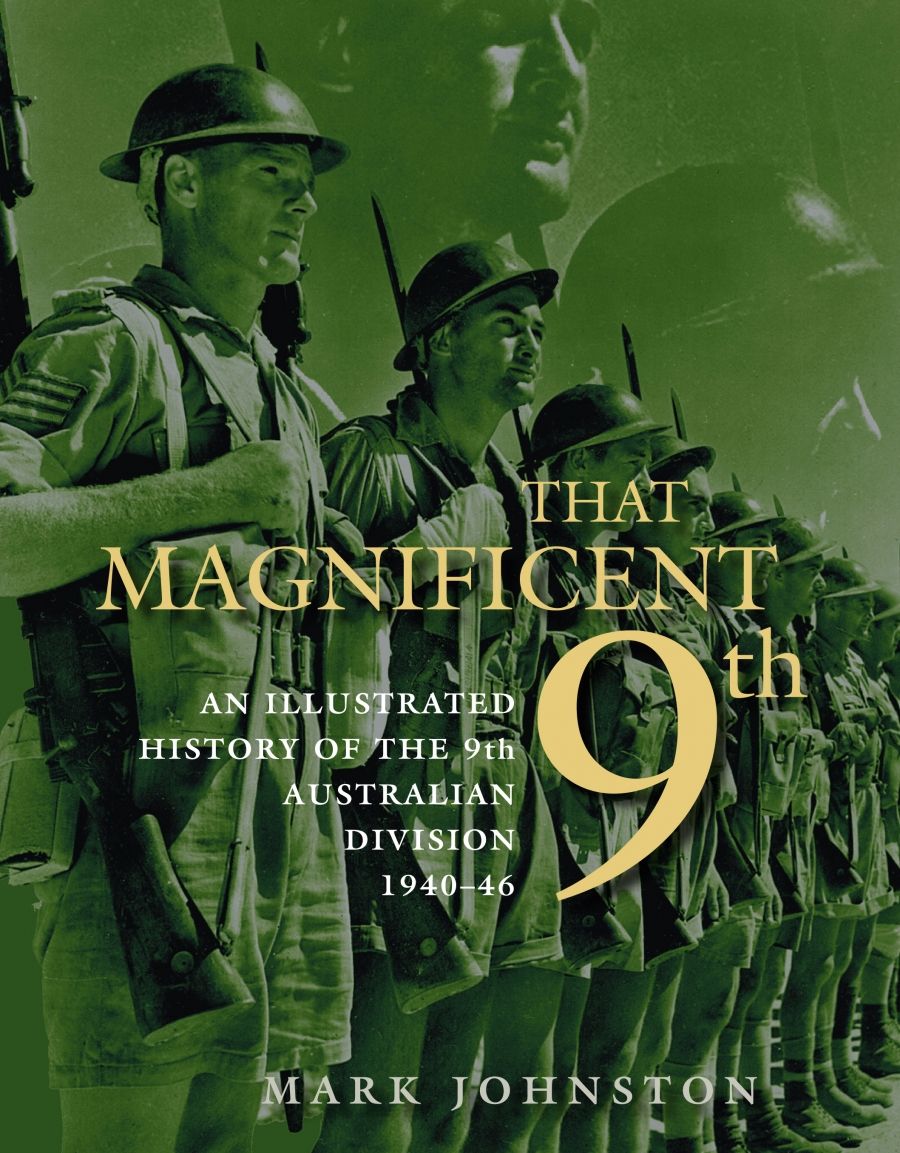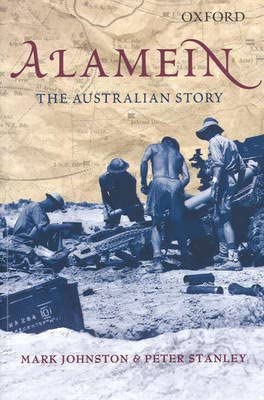
- Free Article: No
- Contents Category: Military History
- Review Article: Yes
- Article Title: Great upstarts
- Online Only: No
- Custom Highlight Text:
At 9:40 pm on 23 October 1942, in the North African desert, the heavens lit up with myriad flashes from more than one thousand guns, and the roar of the British Commonwealth Eighth Army’s opening barrage rolled out towards Field Marshal Rommel’s poised Panzerarmee Afrika. Promptly, at 10 pm, when two search-lights arced across the sky, beams crossing, the waiting infantry from Australia, Scotland, New Zealand, South Africa, India, and Great Britain rose from weapon pits, where they had been lying doggo all day, and began to fight their way forward through wired and dug defences, and ingeniously laid enemy minefields stretching up to six thousand metres deep.
- Book 1 Title: That Magnificent 9th
- Book 1 Subtitle: An illustrated history of the 9th Australian Division
- Book 1 Biblio: Allen & Unwin, $49.95 hb, 288 pp
- Book 2 Title: Alamein
- Book 2 Subtitle: The Australian story
- Book 2 Biblio: Oxford University Press, $55.00 hb, 326 pp
- Book 2 Cover Small (400 x 600):

What comes through strongly in the book is the intensity of the fighting. The authors’ emphasis is on the socio-tactical: that is, how individual soldiers felt about their part in the battle, and what they achieved collectively along the way. The human anecdotes and personal experiences of combat tumble over each other to compete for our attention. One action that deserves and receives special mention was the night attack to capture Trig 29. In desert terrain that was almost never totally flat, it was still rare to find features that dominated the surrounding country. Trig 29 was only six metres higher than the area around it, but its importance as an observation post and centre for directing artillery fire on the northern flank of the 9th Division’s attack was recognised immediately by Montgomery and also by Rommel when he arrived back, still sick, from Germany. The 2/48th Battalion, in a brilliant carrier-borne coup de main, captured it on the night of 25–26 October. So sensitive was Rommel to its loss that his celebrated Afrika Korps launched no fewer than twenty-five unsuccessful attacks to regain it. The combination of dogged infantry defence and superbly directed artillery fire broke up every attack and stopped others before they could get going.
Probably the toughest fighting of the entire campaign occurred over four days in an area known as the ‘saucer’, astride the main road and railway near the sea, and sandwiched between two places with epic names: the ‘block-house’ and Barrel Hill. So depleted had the battalions of the 9th Division’s 26th Brigade become that Major-General Leslie Morshead was forced to make a decision of high moral courage. In effect, he relieved the defending brigade with a relatively fresh brigade – the 24th. Had Rommel’s repeated attacks broken through, it would have negated the Eighth Army’s previous gains. It would also have set back the war in the desert by several months.
Despite the general quality of the narrative, there are some surprising omissions. Although the dust-jacket blurb refers to the authors as ‘among the first to consult German and hitherto secret British records, especially Ultra Signals’, there is inadequate reference to the most far-reaching Ultra decrypt, which the British official historian described as ‘perhaps the most important single item of information that the Enigma [the German encoding machine] had yet contributed to the desert campaign’. It not only contained an outline of Rommel’s future intentions, it candidly listed the mounting difficulties that the Panzerarmee would face the longer the campaign went on. It also apprised Montgomery of the direction of Rommel’s next offensive. As staff cadets at Duntroon way back in the 1950s, my classmates and I had been told by our military history instructor that Montgomery’s cumulative series of successes were based on his great gift for divining the enemy’s intentions. It would have been helpful had we known about Ultra: but then, of course, no one did, except for a chosen few.
Again, there is a tone of cynicism in the book about Montgomery’s performance: that, for example, he had a squeaky voice, wore funny hats, and ‘was the least likely hero to emerge from the ruck of British generals’. This superficially clever caricature is not necessarily compelling. I was fortunate enough to interview Field Marshal Templer on a different subject. He had not served in North Africa, but he had served under Montgomery on a number of occasions, and, as a later Chief of the Imperial General Staff himself, he knew the British Army during and after the war as few men knew it. His belief was that Montgomery, with his great gifts as a trainer and supreme organiser, was the only British commander who could effectively have ‘gripped’ the Eighth Army – especially the British armour, which tended to wander off and fight its own war – in a way that squarely addressed the central task of defeating Rommel and the Panzerarmee. General Ritter von Thoma, who commanded at Alamein until Rommel returned from sick leave, later said of Montgomery: ‘I thought he was very cautious considering his immensely superior strength but he is the only Field Marshal in this war who won all his battles.’
The second book, That Magnificent 9th: An illustrated history of the 9th Australian Division 1940-1946, also written by Mark Johnston, has the unique distinction of telling the 9th Division’s entire wartime story through the medium of more than 200 photographs. They trace the Division’s history through the growing pains of recruit training to its final campaign of the war, at Brunei-Labuan in north Borneo. Each photograph is accompanied by a brief but interesting narrative that sets it in the context of the particular campaign or battle, and gives the reader helpful insights. The coupling of cause and effect, or challenge and response, is continued wherever possible, and adds to the cohesion of the succeeding images of the war.
The photographs are well-chosen. Many have come from the Australian War Memorial’s excellent collection, but a good number have also been contributed by individuals who took part in the various actions. The 9th Division is an outstanding subject. A number of us, including this reviewer, believe it is one of the great divisions of the world, and the author’s enthusiasm for his subject supports that contention. He also points out, however, that many of the original recruits assigned to it were not keen to be 9th Division men. There was more prestige in being in a lower numbered formation – the 6th, 7th or 8th – just as there was in having a lower ‘X’ (i.e. AIF number). Alternatively, recruits in the 9th were called ‘upstarts’ for being new on the block, or ‘deep thinkers’ for hesitating so long before making a commitment. Events changed this. They had a swifter apprenticeship than any other AIF division by being sent to Cyrenaica to face Rommel’s Afrika Korps, then into Tobruk to withstand an epic siege. At that time, they had not even come close to completing their collective training, nor had they been given their entitlement of weapons or equipment. After the 9th Division’s great performance in Tobruk, those impediments almost ceased to matter.
As a division, they were also lucky. For the rest of the war, except for one occasion on Tarakan, they fought concentratedly in a way that no other AIF division was able to do. Certainly, those who had been taken out of the 8th Division to form the 9th blessed their good fortune in not having had to face the Japanese in Malaya–Singapore, or on the islands of Ambon and Timor, or in Rabaul. Many of the photographs of their exploits stand out. One of the most memorable is an aerial shot of the great parade on the Gaza airstrip after the battle of Alamein, just before the division was repatriated to Australia to fight the Japanese. The parade of a whole division is unusual, and this one was special. At Major-General Morshead’s invitation, General Alexander, the Commander-in-Chief, Middle East, took the salute and, in a personal and inspiring address, praised the division’s performance and that of the many men who had fallen during the battle. In the author’s description:
The division stretched out for over three-quarters of a mile … Passing in review from right to left on the airstrip ... [the photograph] looks rather like a tactical map of some ancient battle … This was an unforgettable day for every man in the parade.
Indeed, the whole book is a gracious tribute to a great division.


Comments powered by CComment